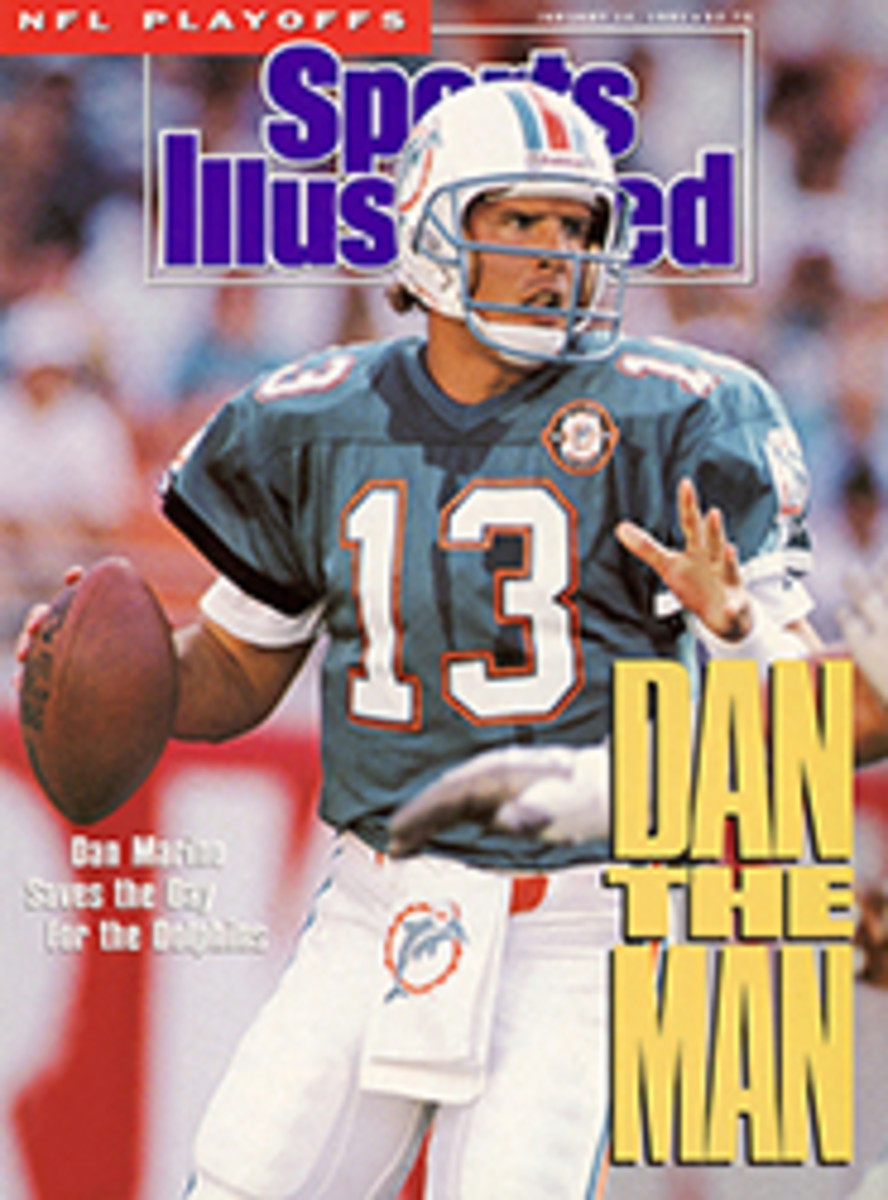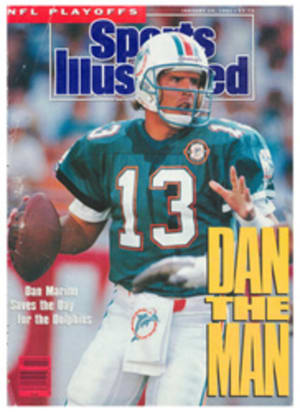
IT'S STILL THE STUFF OF DREAMS
I spent my youth in uniform. Each season I changed sports looking for my medium. Then I discovered the slam dunk. The first time I saw somebody dunk must have been on television, because I never saw-anyone in Levittown, N.Y., stuffing a basketball in the early '60s.
For years I was pure aspiration. At 12, I jumped high enough to graze the underside of the rim with my fingertips. In a heady progression of personal feats, I dunked a tennis ball, a softball and a volleyball. Then, in the summer months before my sophomore year in high school, I grew to six feet four. I would never grow another millimeter, but it was enough. Late one afternoon I felt the power. By myself I walked to the court that was behind my old elementary school. I backed up to half court. Unable to palm, I cradled the ball, charged the net-less rim and dunked with two hands.
I played center on the Memorial High School basketball team from 1961 to '64, tossing in a lot of fadeaway jump shots, but my creativity and impulse for drama played themselves out on the layup line before games. I dunked, and I dunked some more. In fact, I dunked every time I got my hands on the ball. More entertainer than competitor, I knew that the dunk was good theater. It was both the sweet arc of a home run and the punctuation of a third strike or a knockout punch.
I promoted the shot so strenuously that my classmates rose in the stands with chants to feed my pregame dunking frenzy. I even labeled myself The Dipper, after Wilt Chamberlain—who was doing a lot of dunking in those days—and referred to myself so often by that name that I made it stick.
It is 30 years later, and at 44, I can barely master the shot that had become a part of my identity. Now I throw the ball off the backboard with my right hand and tip the feeblest of dunks in with my left. I have heard whispers behind my back that the maneuver is more of a "dink" than a dunk. There is some truth to the charge, but like anyone who can't leave the stage, I keep trying in the hope that a new exercise, drill or type of sneaker will afford me a few more years as a dunker. I came into manhood dunking and, frankly, I fear a dunkless middle age. I shudder to think that the future holds a softball, a tennis ball and then oblivion.
I teach in a community college in New-York City where I play some games for the faculty basketball team. My failure to complete an array of attempted aerial maneuvers has prompted a crew of campus wits to dub me Air Boredom. They don't understand. They are of an age in which the dunk is considered commonplace. Their world is a riot of 360's, reverse slams and televised all-star dunking contests.
Even admen have joined the act, orchestrating commercials in which yuppies go one-on-one in home driveway games. Suddenly one of the handsome young consumers rises above his buddy and as slow motion kicks in, throws one down through his garage basket. The bogus commercial dunk must be a violation of some FCC regulation that requires a semblance of reality in advertising. A few months ago, a trend-conscious staffer even set up a temporary basket and backboard on the White House lawn so that President Bush could get off a dunk in front of the cameras before some ceremonial presentation. Of course, there was no mention of the height of the basket.
The young bloods of today don't know about the time when the dunk was a rare treat. When Elgin Baylor did his herky-jerky along the baseline and slammed in Bill Russell's bearded face, my phone rang off the hook as delighted fellow dunk connoisseurs called to register their appreciation. And the kids today certainly don't know about the years when the dunk was under siege.
On March 29, 1967, the NCAA rules committee banned the dunk in college ball. For 10 seasons, until the shot was brought back for the '76-77 season, no player was allowed to slam, push or otherwise hurl the ball through the basket. The rule makers went further. They instituted a ban on dunking in pregame layup drills that still stands. "Dunking is prohibited by rule," the regulators wrote, citing excessive injuries and equipment damage, "so it has no place in the practice program [read layup drill].... No player shall dunk or attempt to dunk a dead ball."
There have long been whispers that the antidunk regulation was designed specifically to rein in Lew Alcindor (now Kareem Abdul-Jabbar), who had just capped his sophomore year at UCLA by leading his team to a national championship. Jabbar himself is reluctant to lend his voice to the conspiracy theory. He can afford to remain above the issue. We all know how he devised the skyhook and loped off into the sunset. Much more handicapped by the NCAA ban was Julius Erving, who didn't gain the exposure in college that he might have otherwise. His unheralded career at the University of Massachusetts—where he was second in the nation in rebounding in 1969-70—can be explained, at least in part, by the banning of the shot he would make famous in the 1970s. The Doctor was definitely hurt.
And, in my own way, so was I. I played small forward in the Ivy League from 1965 to '68, and though I never did get off any game dunks in my sophomore year, I did unleash a barrage of slams in the layup drills. I missed my entire junior year because of an injury, and when I came back as a senior, the dunk had been outlawed. Even the possibility of dunking during a game had been taken away, and the layup drill was reduced to a dreary-exercise.
After college I took my dunk to the schoolyards of New York City, where I was considerably humbled by what I found. New York is the spiritual home of the stuff shot—the place where Connie Hawkins learned to cuff the ball and sling it down backhanded—and the home of the Rucker Tournament, a veritable dunk bazaar.
Like a Rhode Island surfer who moves to Hawaii, I did a lot of watching. At West Fourth Street in Greenwich Village, I saw an unknown 5'10" player named Clyde Brown muscle his way down the lane, carry a defender on his shoulder and ram home a monster dunk. The game wasn't over, but the shaken defensive man collected his jacket, slipped through a hole in the fence and disappeared down the steps to the A train. In New York and other big cities it is often not that you score but how you score, and the straight-in-your-face dunk shot is the ultimate symbol of domination. As such, it is cause for on-court consternation and humiliation as well as widespread viewer jubilation.
After its return to the college game in '76, the stuff shot developed in popularity to the point where it is now the centerpiece of both the college and pro grames. No TV basketball promo is complete without a dizzying array of windmill slams. Michael Jordan is an icon in great part because of his signature dunk. The Hawk and the Doctor would flourish the ball in their huge hands and rifle it through. Jordan vaults to a leaning position, eyes level with the rim. Arm cocked, tongue wagging, he hones in on the hoop like a heat-seeking missile before he crams the ball home.
But the great Jordan also stands on the shoulders of other giants: Darrell Griffith, Dr. Dunkenstein and his Louisville Doctors of Dunk; Clyde (the Glide) Drexler and Houston's Phi Slamma Jamma; David Thompson; Dominique Wilkins; Spud Webb; Ollie Taylor (known in the ABA as the Flying O); and Darryl Dawkins, who was so fond of his dunks that he gave them names.
And what about me? I have my memories and my fading dink. I remember my first year out of college. A newcomer to New York, I walked the lonely city looking for a game. On a darkened street I heard the muffled thump of a basketball, like a heartbeat. I climbed the stairs to the gym, but the elementary school night center was just closing. The last ball was slipping into a fishnet bag. "Mister, can you dunk?" a young boy asked. I nodded. They handed me the ball. Twenty-five 10-year-olds stood still. Taking three steps, I rose to the rim and jammed the ball through with a grunt. There was a howl of delight from the assemblage. Then silence. The ball was returned to my hand. I delivered a hesitation two-hander. The night-center director had had enough, but I hadn't and neither had the kids. He allowed a final dunk. Then I was out on the street again, alone, walking.
Ernest Hemingway feared the day he would be unable to make love. I have the same fear of losing the dunk. My girlfriend doesn't understand, but my buddy Mike does. A 45-year-old six-footer, Mike was a college player who never dunked. But he hasn't given up hope. He experiments regularly with leaping drills and remains confident that the first line of his biography will read, "Unable to dunk until the age of 50...."
Greg Donaldson is a free-lance writer who also teaches at New York City Technical College.
TWO ILLUSTRATIONS
JOHN ROMBOLA

